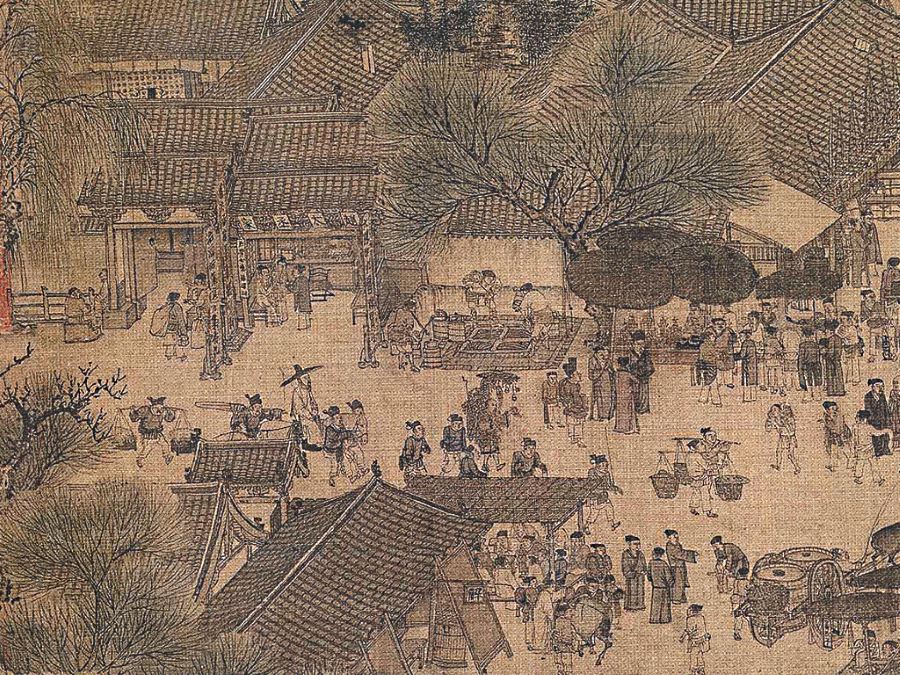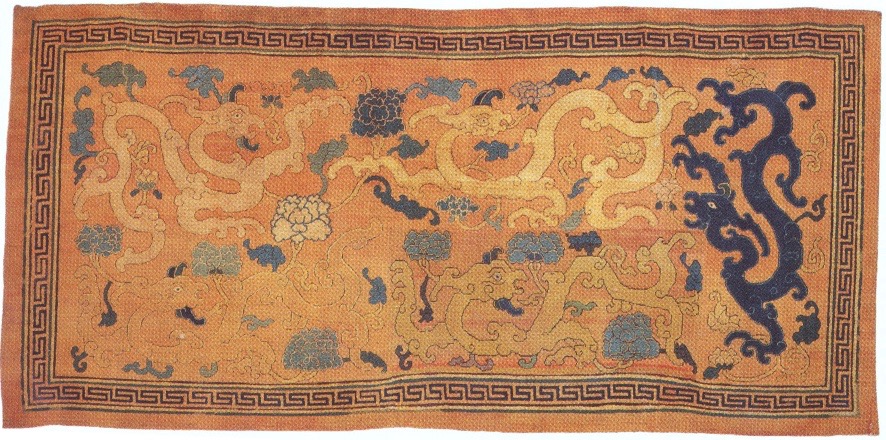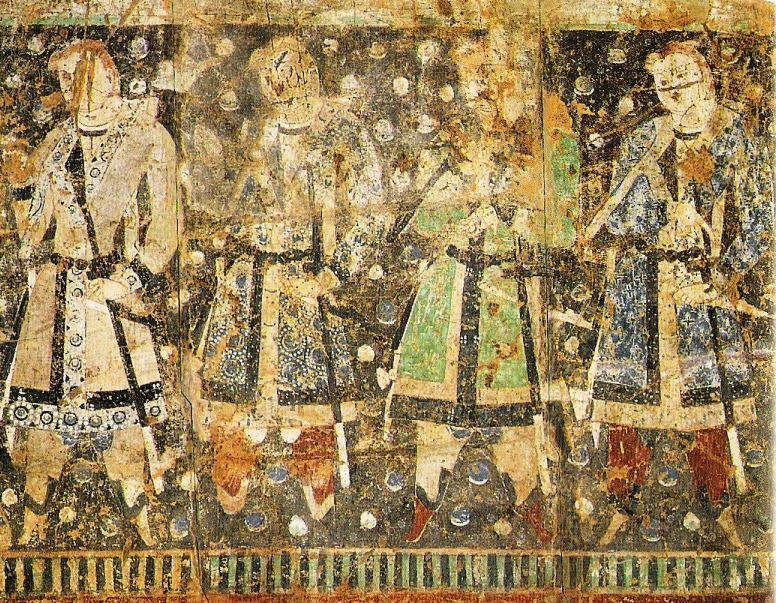
The Salon du Tapis d'Orient is a moderated discussion group in the manner of the 19th century salon devoted to oriental rugs and textiles and all aspects of their appreciation. Please include your full name and e-mail address in your posting.
by Pierre Galafassi
Most of the earliest examples of rug pictures are found in central asian murals from the 5th to the 12th century CE and in 12th-14th century Chinese manuscripts describing nomads. Some pictures show credible ancestors of much later extant rugs, while other pictured rugs died without descent.
While the sedentary Han- and Tan’g Empires did not have much use, nor interest for rugs (1) (2),
for their northern- and western nomad neighbors of indo-european and
turko-mongol stock, felt- and pile carpets were esencial in daily life.
They also played an important social role, as the 5th century BCE
Pazyryk rug demonstrated.
Some nomad ethnic groups, (like the 7th century BCE Persa tribes which
created the Achaemenid empire, or some Turko-Mongol nomad
confederations which, after the 8th century CE, conquered large settled
kingdoms west of the Pamir- and Hindu-kush ranges) did keep their
rug-making traditions even when they became partially settled.
Logically, rugs were probably also appreciated and produced in some commercial hub-cities situated near nomad territories.
Xuanzang, a buddhist monk who traveled to India in search of sacred
texts, wrote an interesting report of his journey, mentioning
carpet-weaving cities (4):
He left Tan’g-ruled China in 629 CE, took the northern branch of the
silk road (southern piedmont of the Tian Shan range), went through the
territory of the Göktürk Khanate, turned south, crossing Sogdia near
Samarkand, then through the Hindukush and Afghanistan and reached
India, where he stayed until 643 CE visiting Buddhist monasteries,
before walking back to China, this time via Kashgar and the southern
branch of the silk road.
FIG 1. Timeline of central-asian civilizations

FIG 2. Map of the central asian part of the silk road

During his long
journey the monk mentioned rugs twice: He warmly praised the carpets of
the important city of Kashgar ‘.. carpets of a fine texture and
skillfully woven ..’. At the time Kashgar was still mainly
populated by ‘green-eyed barbarians’, (most probably Sogdians and
Tokharians), and was a vassal state of the Gökturks.
His longest stop on his way back to the Chinese Tan’g capital Chang’an,
was at Khotan, well known since centuries by the Chinese Court for its
supply of precious jade, and where again Xuanzang mentioned beautiful
woolen rugs and felts, as well as fine silk textiles.
Archeology has found clear proofs of important production of wool
pile rugs in several city-states situated on the southern- and
northern branches of the silk-road, in the Tarim basin.
For example at Niya (east of Khotan), 3rd-4th century CE
documents contain references to valuable carpets traded for vineyards
or slaves. (5)
At Shanpula, near Khotan, an intact wool pile rug from the 1st century
CE (fig 3) and two others from the 5th-6th CE, in pretty good shape
too, (fig 4) have been discovered.
FIG 3. Shanpula, Khotan. 1st BCE-1st CE. Han dynasty. Xinjiang Museum

FIG 4. Shanpula, Khotan. 5-6th CE. Figurative, 265x150cm!

FIG 5. Shanpula, Khotan. 5-6th CE. Rather psychedelic rug, inscribed in khotanese.
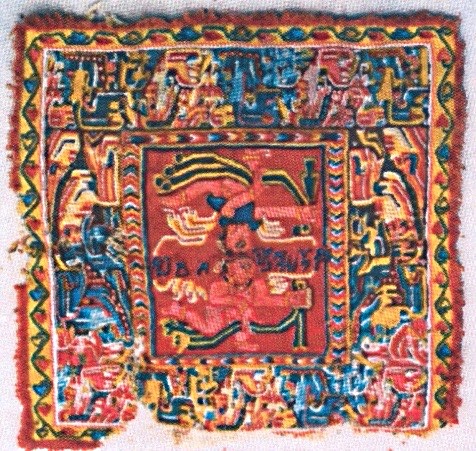
Btw. the rugs in
fig 4 & 5 own their shrieking colors much more to photoshop than to
natural dyes. We must try to imagine them a bit less flashy.
At both Niya and Loulan, a large number of wooden carpet-beaters
from 1st to 3rd century CE have been discovered, as well as fragments
of sophisticated pile carpets from the 2nd to 4th century CE) (7).
FIG 6. Carpet Beaters. Niya. 1st to 3rd CE. V&A Museum, Aurel Stein coll. London

FIG 7. Loulan Yinpang tomb. Crouching lion. 3rd-4rd CE.
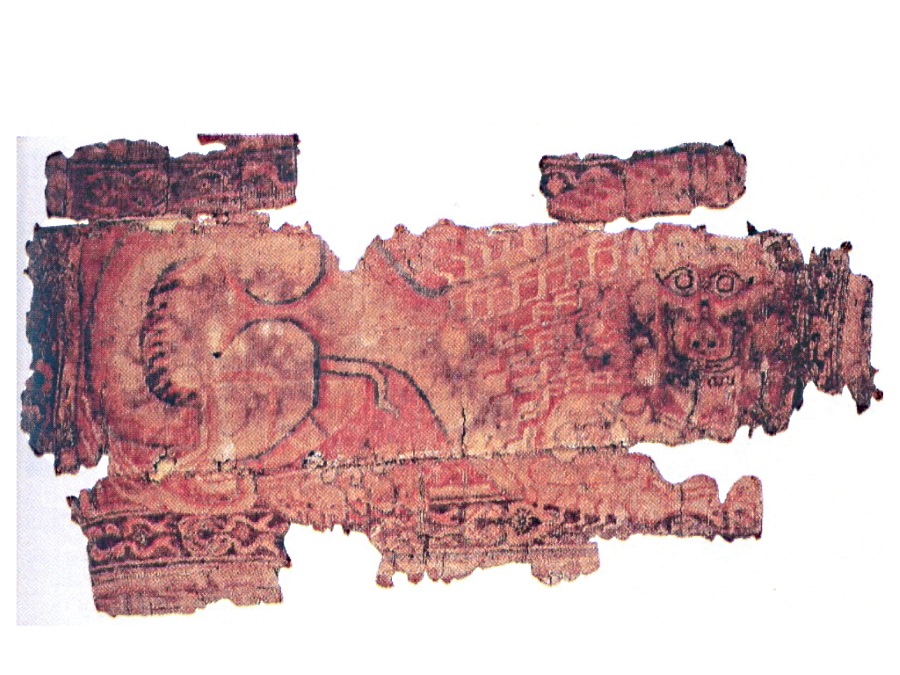
FIG 8. Loulan. Pile rugs fragments. 2nd-4th CE. V&A Museum, Aurel Stein coll. London
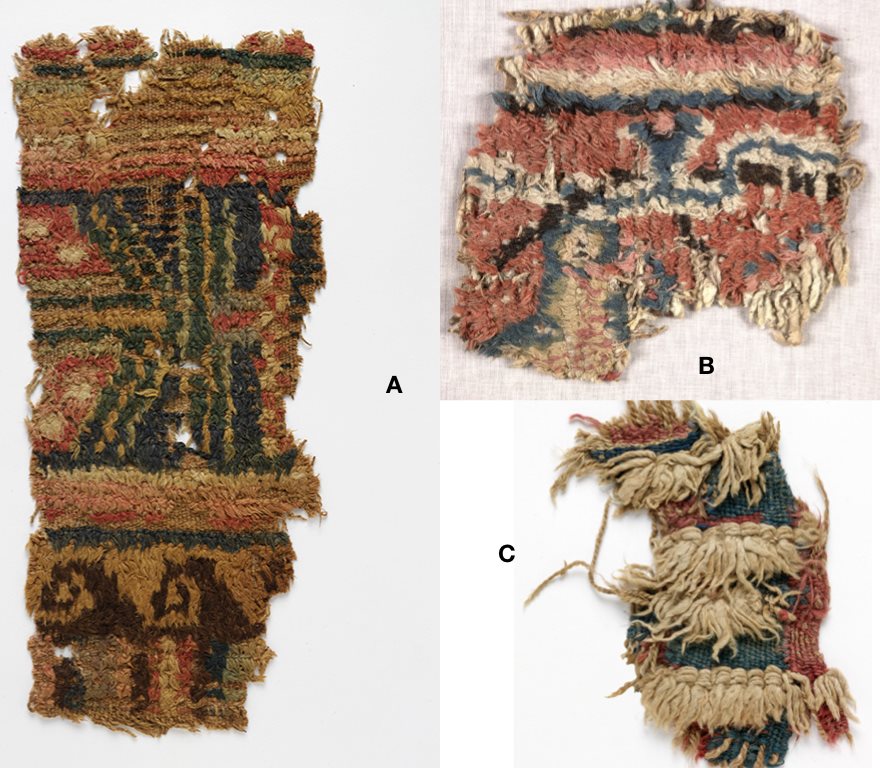
The dyers knew their job too: The fragment 8A features 8 colors!
The chemical analysis of Niya- and Loulan fragments identified a large
number of good natural dyes, for example red dyes extracted from Rubia
tinctorum, Rubia cordifolia (manjeet), and from eastern varieties of
Cochineal and Lac!
There can be little doubt therefore that the inhabitants of the tiny
city-states at the periphery of the Takla Makan were very active and
competent carpet- and textile weavers (8).
This essay is not the best place for another lively discussion (9)
about the ethnic origin of the weavers of the two oldest extant rugs
known, the famous 5th BCE Pazyryk carpet, and the lesser known
6th BCE Bashadar fragment (10),
both discovered in the Altai range, just north of the Takla Makan, but,
imho, there is no serious reason for not adding Tarim Basin people to
the list of their potential weavers.
At the time of Xuangzang’s journey, Sogdia, (west of the Pamir), was
called home by the most active business people in central- and eastern
Asia. The Sogdians were well known in China. Large and successful
colonies of expats lived in the capital Xi’an / Chang’an, in other
large cities of the Empire and even in some lost northern outposts
close to the Turko-Mongol steppe. Sogdians and other ‘western
barbarians’ were usually pictured sitting on rugs by Han ceramists and
painters. Rugs were as much a marker for ‘western barbarians', as big
hooked noses, bushy beards, protuberant eyes or red hair. Rugs were
also a traditional marker for all those truly annoying Turko-Mongol
horsemen of the North.
FIG 9. 9A: Sogdian camel driver. Ceramic. 5-6th CE. Northern Wei dynasty. Cernuschi Mus.
9B: Barbarian band. Ceramic. 7-9th Tan’g dynasty. Nat. Mus. of China. Beijing.

FIG 10. 10A. Sogdian horseman. Ceramic. 7-9th CE. Tan’g Dynasty. Musée Guimet.
10B. Sogdian. 7th CE. Mural. Afrasiab (Samarkand) Sogdia.
Zoroastrian procession.

FIG 11. Sogdian. 7th-8th CE. Pendjikent, Sogdia. Fallen warrior.
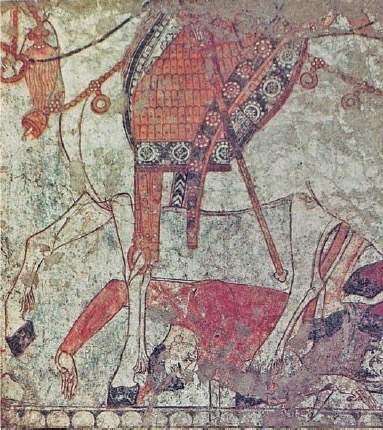
FIG 12. Sogdian. 7th-8th CE. Pendjikent, Sogdia.
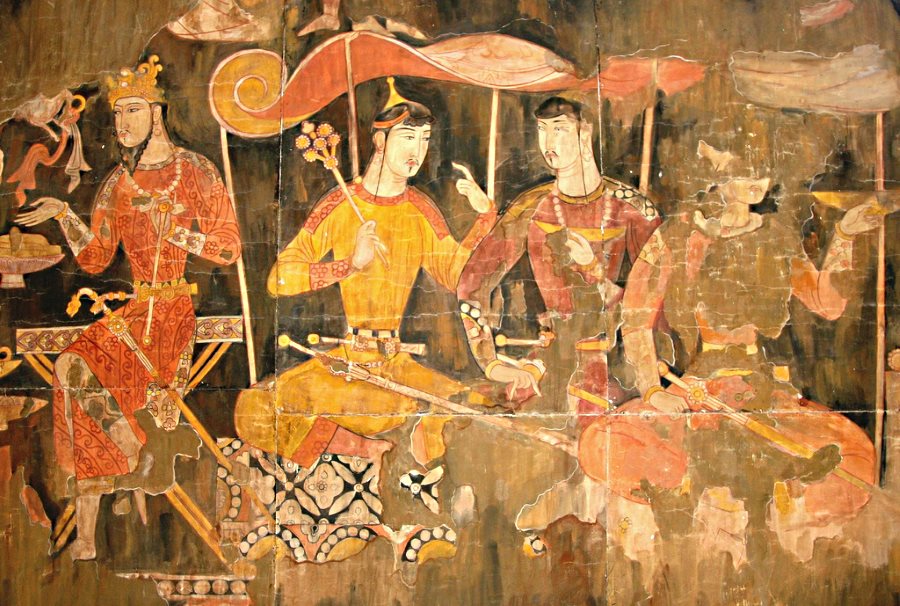
Not
surprisingly, Sogdian rugs often featured the Sassanian / Sogdian
‘Pearl and Roundel’ motif, or at least pearl borders.
The large extant fragment from the 6th or 7th CE, in fig 13, is generally attributed to Sogdian- or Tokharian (11) weavers too.
FIG 13. Sogdia or Tokharistan 6-7th CE. Extant rug fragment. Kuwait Nat. Museum.

An Jia, a very
successful Sogdian expat in Xi’an, China, has left a sumptuous, painted
funerary couch featuring about a dozen rugs. A leader of the Sogdian
business community in Xi’an during the fleeting Northern Zhou dynasty
(second half of 6th CE), An Jia was as well an employee of the Chinese
‘foreign office’, responsible for taking care of ambassadors and
envoys. The sculpted and painted stone panels show him lavishly
entertaining several Turk envoys, either in a Yurt in the steppe or in
his city residence.
Although frustratingly little is visible of each rug and the sculptor
did not indulge in details, one can see a border of pearls ( Sogdian
marker) and saturated red grounds scattered with stylized floral
patterns. Not all rugs have a red ground though. In fig 14 B, a merry
Sogdian is sitting on a rug with yellow ground. In fig 15 B, a Turk and
a Sogdian are playing dices, seated on a rug which has lost most of its
original color. It may have been blue though (12).
FIG 14 Sogdian. Funerary couch of An Jia. Xi'an. Northern Zhou dynasty. 6th CE

FIG 15 Sogdian. Funerary couch of An Jia. Xi'an. Northern Zhou dynasty. 6th CE

On the
northeastern side of the Takla Makan, the buddhist Qizil caves/temples
contain wall paintings with obvious stylistic influence from India, but
also with a number of rugs which own nothing at all to India:
Some with a lattice of green hexagons (each containing a tiny
boteh-like motif) and a red main border are reminiscent of rugs
featured in some Timurid miniatures. Others show a lattice of
either lozenges or spirals on a saturated blue ground and red border.
These motifs do not match well with the so-called SerIndian style of
the cave paintings, thus one can suppose that the painters did
reproduce local weavings.
Well, this could be the right place for a warning:
We should not take it as granted that the colors of the rugs
illustrated in these wall paintings, perfectly match those of real rugs.
There is of course the possibility that the painter made sometimes use
of his right for inventing them, but I am especially alluding here to
the fact that the number of pigments suitable for wall-painting
was very limited at the time and that they had, at least, two major
drawbacks:
- Due to the limited number of colors offered by these mineral
pigments, the painter found it difficult to match exactly the real
shades of wool rugs (made possible by the large number of good
plant- and insect dyes available).
- Nearly all these mineral pigments were chemically unstable, and their
color was therefore quite susceptible to change significantly over
time. (12)
FIG 16, FIG 17, FIG 18, FIG 19. Qizil caves. 7th-9th CE Tan’g dynasty. MIK. Berlin.

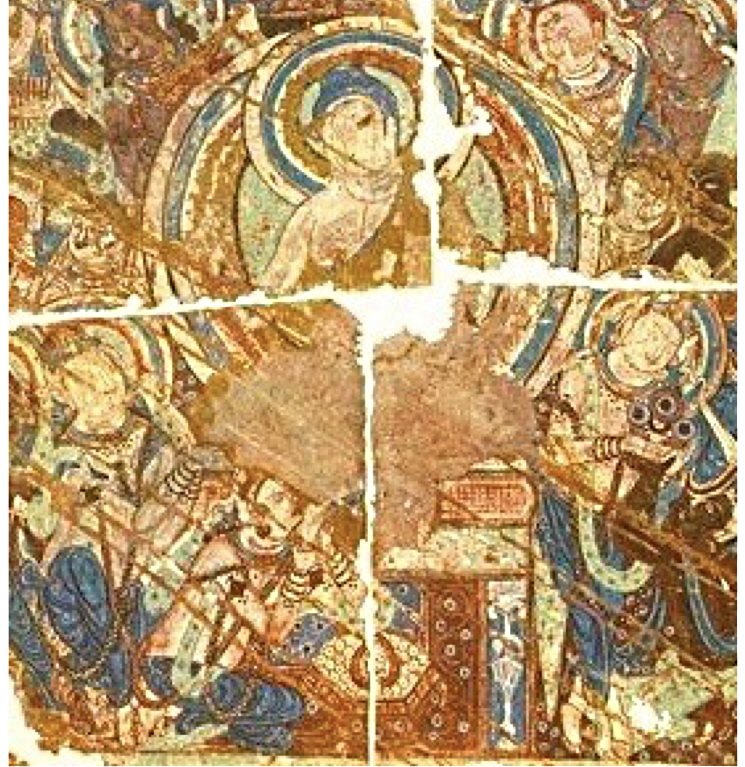
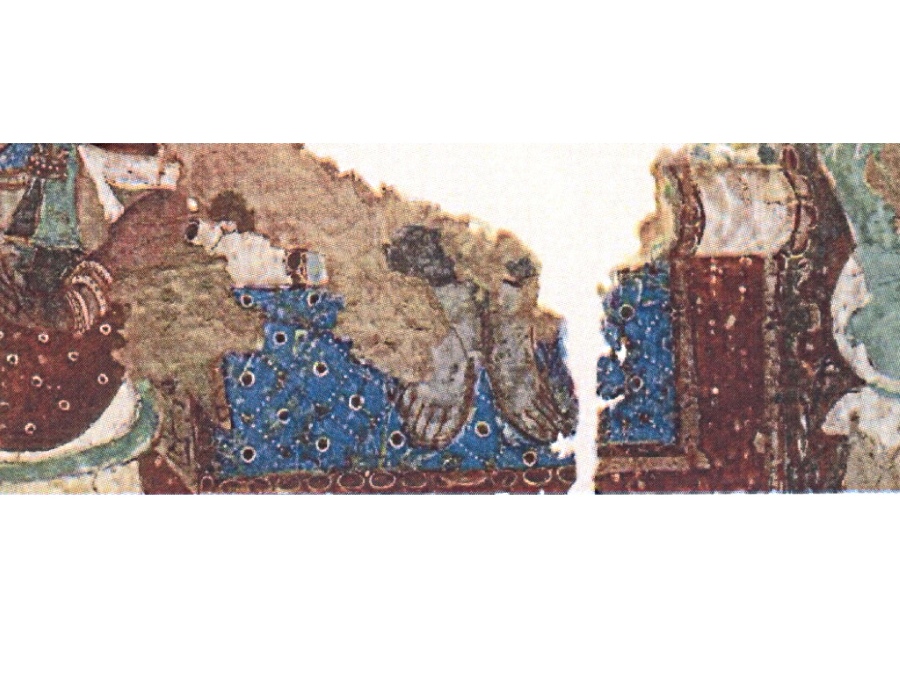

Rugs with a
saturated blue ground and a red main border can be seen in murals of
the Mogao buddhist caves too. Other Mogao rugs show rows of small pearl
motifs, green on a very pale-green field.
FIG 20. Mogao, Dunhuang caves. Tan’g dynasty 7th-9th CE.

FIG 21. Mogao,Dunhuang caves. Tan’g dynasty 7th-9th CE.
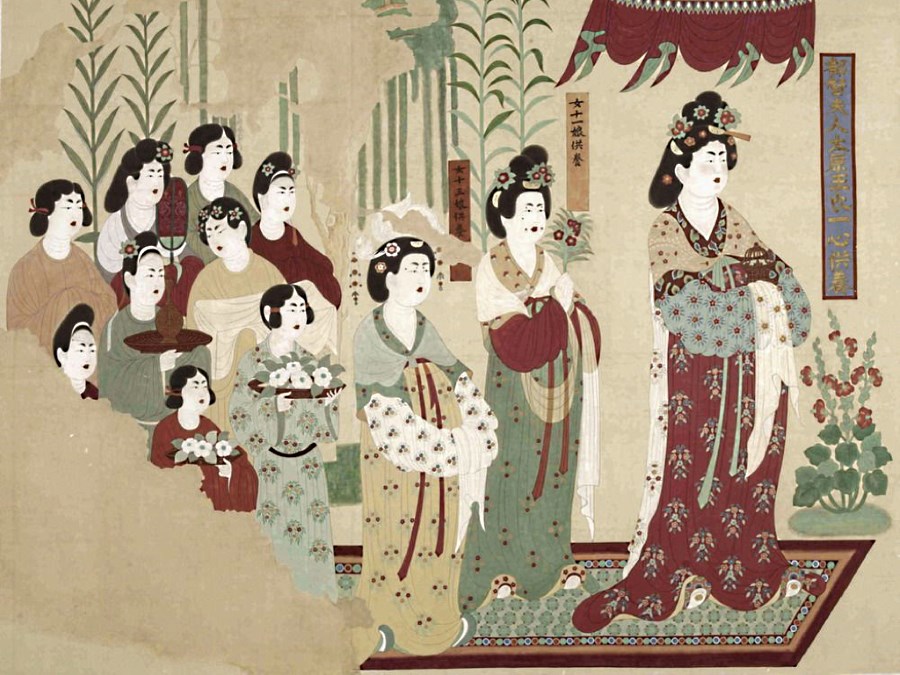
A different style of rug appears on the 10-11th CE painting below.
FIG 22. Mogao, Dunhuang Caves. Northern Song dynasty. 10-11 CE. Khotanese Buddhist donor.

Different again,
in fig 23, a donor stands on a rug with a plain red ground and a very
large main border with palmetto motif and a rare corner solution. Does
it look a bit familiar to you too? A trifle ‘17th-18th century Ottoman’
perhaps?
FIG 23. Mogao, Dunhuang caves. 10th CE. Ruler of Duanhang. Glanz der Himmelssöhne p.11.

At Turfan, Manichean scrolls from the 9th CE show a number of very different styles:
A field with a ‘peacock feather’ motif, another filled with
greenish hexagons and a large red border, another with large and rather
plain indigo ground, a square central motif and a narrow, red and gold,
geometric border.
In fig 25 we see a rug with very pale yellow background and orange
motifs ( peonies?) of a type apparently very popular in the Tarim basin.
FIG 24. Turfan 9th CE Manichean orants BIK. Berlin.

FIG 25. Turfan 9th CE Manichean scroll 1. BIK. Berlin.
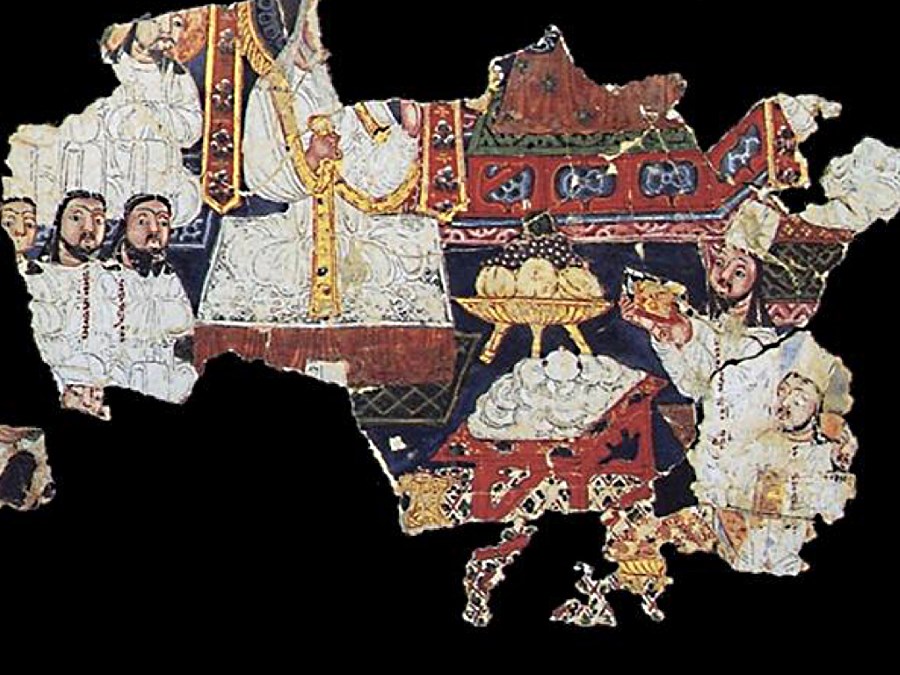
FIG 26. Turfan 9th CE Manichean scroll 2. BIK. Berlin.
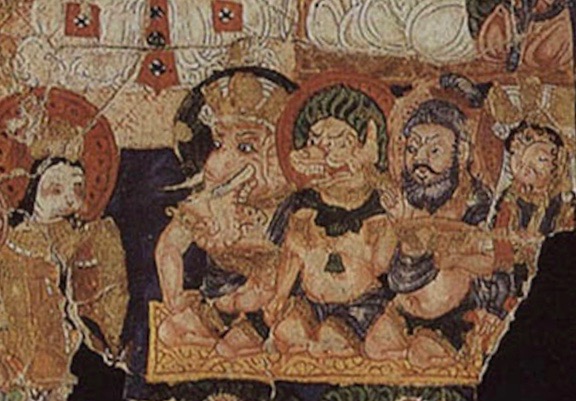
FIG 27. Turfan 10th CE Donors. State Hermitage. Saint Petersburg.
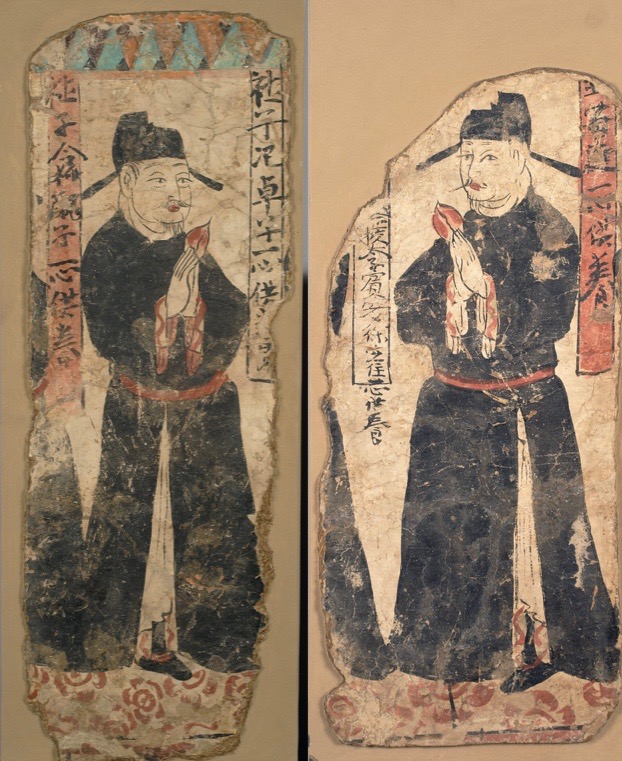
At Bezeklik caves, murals feature three Uyghur princes, walking on a
rug with small and spare orange flowers on a very pale yellow
background. On another mural, two princesses stand on a rug with
an orange ‘peacock-feather’ motif, again on pale yellow background. On
yet another mural, a procession of ranking Uyghur donors progresses on
a rug with a lattice of small orange ‘waves’, again on that peculiar
pale yellow background.
FIG 28. Bezeklik caves 9th-10th CE. Uygur princes. MIK Berlin.

FIG 29. Bezeklik caves 9th-10th CE. Uygur princesses. MIK Berlin.
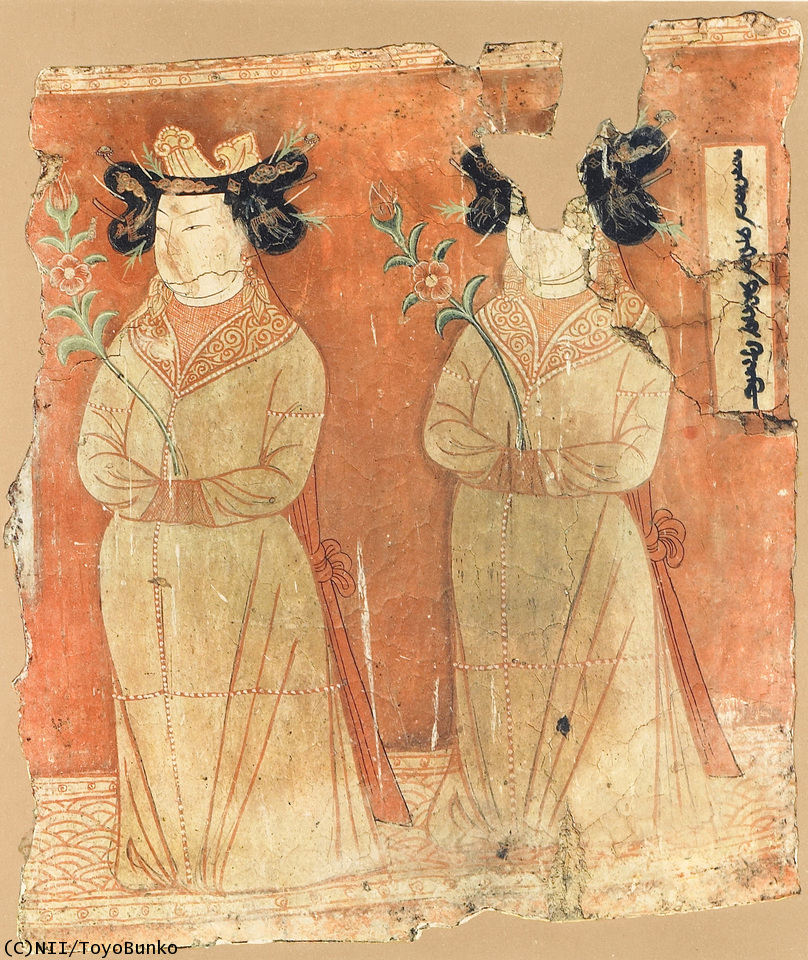
FIG 30. Bezeklik caves 9th-10th CE. Uygur donor’s procession. MIK Berlin.
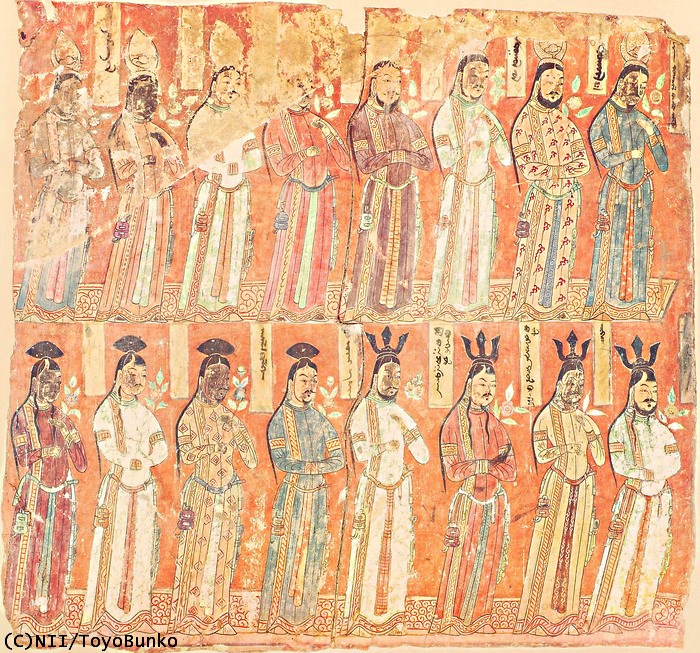
The same « peacock » motif is featured again on a saddle rug in a 9th CE wall painting at Khocho caves .
It is perhaps only a case of independent invention, but a
cultual gold vessel from the Scythian civilization (fig 32 A) and
a ( felt-appliqué) horse-cover from Pazyrik ( fig 32 B) both feature
the, otherwise quite rare, peacock motif too.
FIG 31. Khocho caves 9-10th CE. Saddle rug.
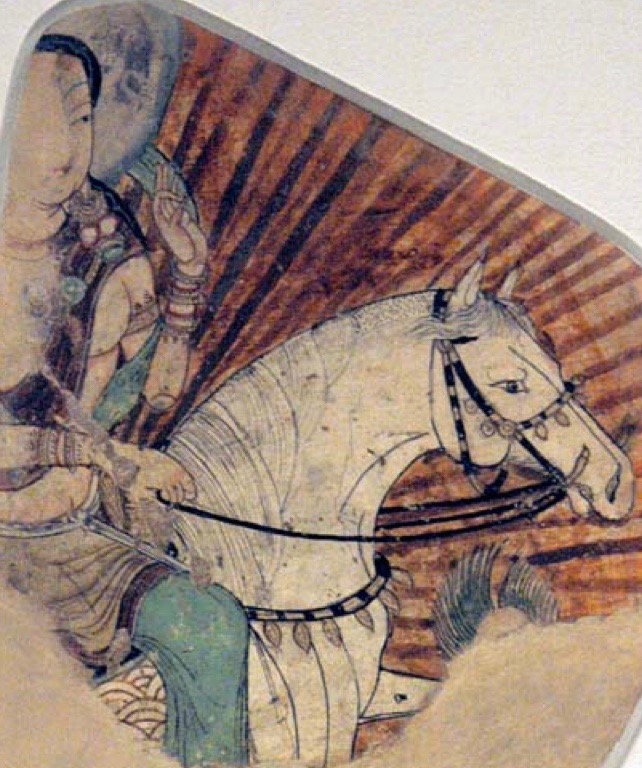
FIG 32. A. Scythian. Cultual gold vessel . 6-7th BCE
B. Pazyryk. 4-5th BCE. Felt horse-cover. Hermitage Museum
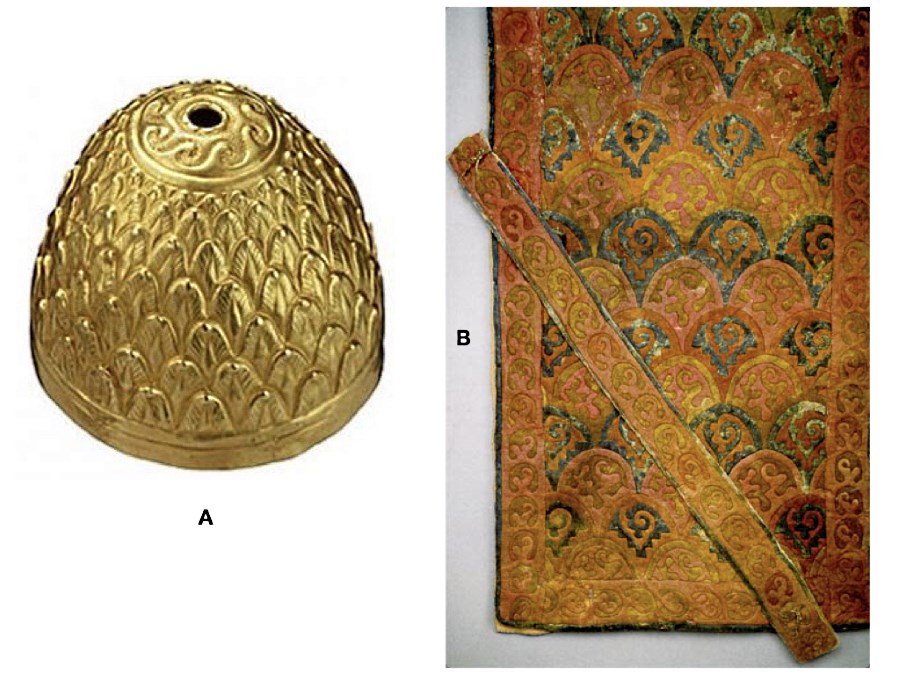
The very pale yellow background and pale orange motif in Bezeklik paintings are perhaps due to a degradation of the pigment. (12).
From Khocho comes as well a Manichean scroll with musicians
sitting on an original rug (pile or appliqué felt?) featuring an
impressive green motif on grey background. (Perhaps the stylized head
of a local caprid, the argali, said to be associated with the spiritual
worlds ?).
FIG 33. Khocho. 10th CE. Manichean manuscript. MIK. Berlin.

Neither the
palettes nor the motifs of most rugs seem to be very consistent with
Turko- Mongol taste as we usually imagine it. Therefore one could
suppose that the rugs used by the cave painters as props were
woven in the oasis-cities bordering the Takla Makan, in a multi-ethnic
environment, with various dosages of Tokharian-, Sogdian,
Indian-, Persian, Turko-Mongol and Chinese influences. If so, it would
suggest that whenever nomad empires annexed these small but active
city-states (and the nearby caves/temples full of Buddhist - or
Manichean monks; all enjoying a direct line to their own gods), they
cleverly refrained from imposing their own taste to their new subjects.
Let’s not disturb the golden-egg laying hens or irritate the gods.
A very popular Chinese legend, describes the abduction of the Han-Era
poetess Cai Yan (Wenji) by a party of marauding Xiongnu (a strong
confederation of Turko-Mongol tribes) around 190 AD, her life as wife
of a Xiongnu ‘Leader of the Left Aisle’ and her return to
China, against ransom, twelve years later.
This story was used by Liu Shang, a Tan’g-Era poet, as the basis
for the ‘Eighteen Songs of a Nomad Flute’, of which several superbly
illustrated versions were later produced, initially perhaps at
the initiative of Gaozong, the first Southern Song Emperor, who is said
to have also lost a member of his own family, abducted by another
Turko-Mongol confederation, the Jurched Jin.
These illustrated versions of the poem, of which some fragments are
extant, describe quite accurately nomad encampments, their attire and,
fortunately, quite a number of rugs too.
The costumes and rugs are not Xiongnu’s, but those of Khitan tribesmen,
responsible for another traumatic Turko-Mongol invasion of China during
the 9th century. They created the Liao dynasty which ruled the
northeastern steppe and in northern China for a while (9th to 11th
century CE).
The rug palette (with its dominant usage of saturated red and blue) and
the geometric motifs are quite familiar to modern ruggies. IMHO it
makes them credible ancestors for the much later Kazakh-, Kirghiz- and
Turkmen rugs, of which we don’t know extant pieces older than the 18th
century.
FIG 34. A. Eighteen Songs of a Nomad Flute. 12th -13th CE. MFA Boston

FIG 34. B. Eighteen Songs of a Nomad Flute. 12th -13th CE. MFA Boston
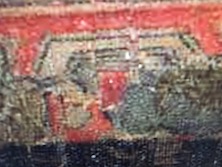
FIG 35. Eighteen Songs of a Nomad Flute. 12th -13th CE. MFA Boston

FIG 36. Eighteen Songs of a Nomad Flute. 12th -13th CE Nat. Palace Taipei Taiwan

FIG 37. Eighteen Songs of a Nomad Flute. 12th -13th CE MET 213006

FIG 38. Eighteen Songs of a Nomad Flute. 12th -13th CE MET 213008
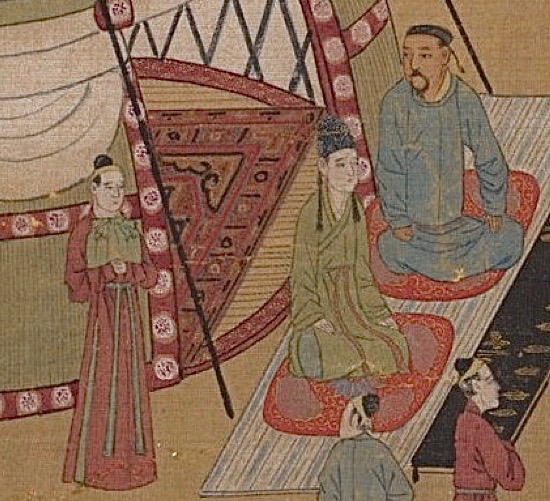
FIG 39. Eighteen Songs of a Nomad Flute. 12th -13th CE MET 213014

FIG 40. Eighteen Songs of a Nomad Flute. 12th -13th CE MET 213015
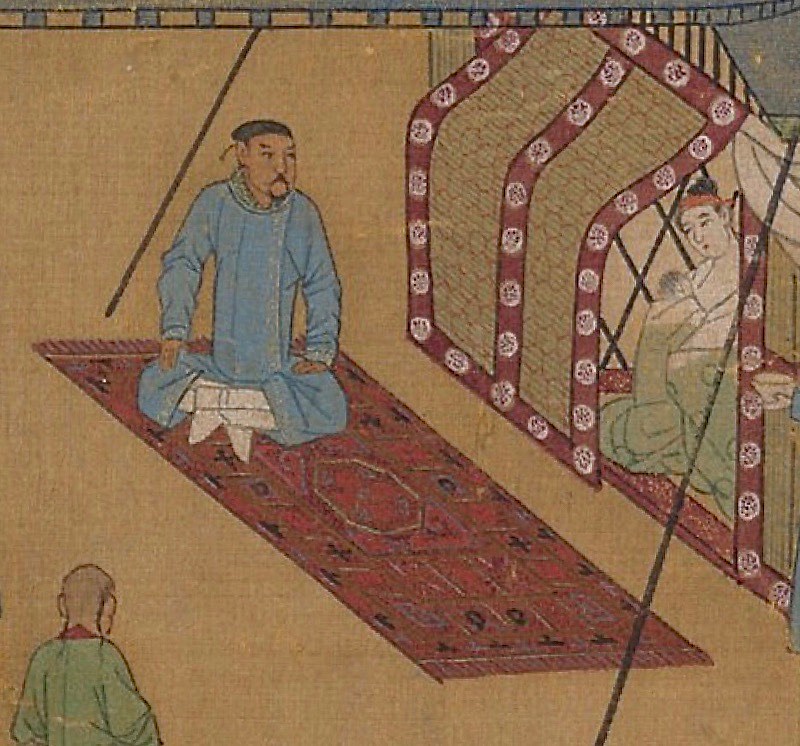
FIG 41. Eighteen Songs of a Nomad Flute. 12th -13th CE MET 213017

FIG 42. Eighteen Songs of a Nomad Flute. 12th -13th CE MET 213019 a
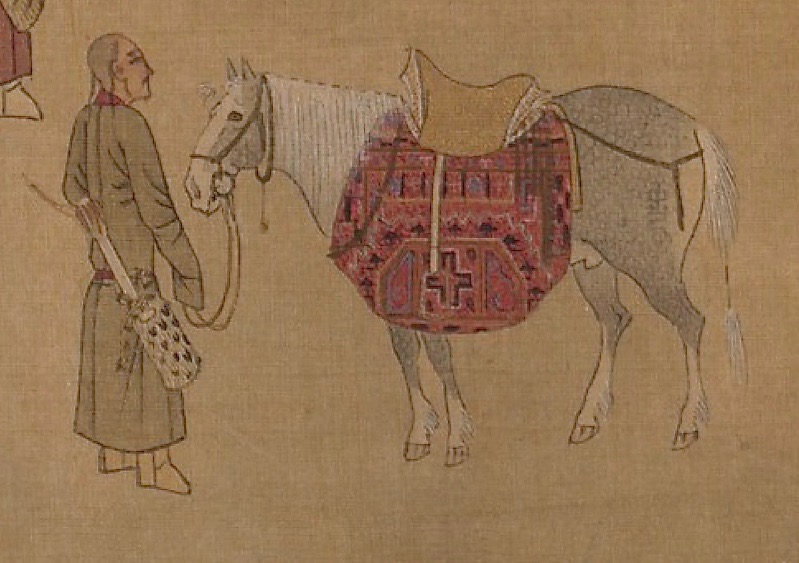
FIG 43. Eighteen Songs of a Nomad Flute. 12th -13th CE MET 213019 b

The Khitan
favored motifs with rows of squares, compartmented fields, central
hexagonal - or octogonal « guls » occasionally filed with a
cross motif.
I am particularly impressed by the rug in fig 36, with its proud
Tamga-like central motif and by the superb saddle rug in fig. 35.
The cross motifs in fig, 40, 41, 42 have been seen by a pious
Ganzthorn’s disciple as a proof for a strong Christian influence in the
Khitan confederation and a further proof of the prevalent role of
Christian weavers in Rugdom. IMHO this enthusiasm could be (again) a
bit premature, since similar cross motifs where already in use in the
region before the first century CE, as shown for example in a Xiung Nu
felt & appliqué rug found in a Noin Ula barrow (fig 44).
Besides Marla Mallet has explained, on Turkotek and in her seminal book
‘Woven Structures’ (13), the weaver’s logic behind the frequent use of cruciform motifs on rugs.
Rather safe than sorry, I nevertheless checked also with the Red
Cross in Geneva, they did confirm that they had no team working in
Mongolia during the first century BCE.
FIG 44. Noin Ula. Barrow 6. Felt & appliqué rug. Xiung Nu. 1st CE-1st BCE. State Hermitage Mus.
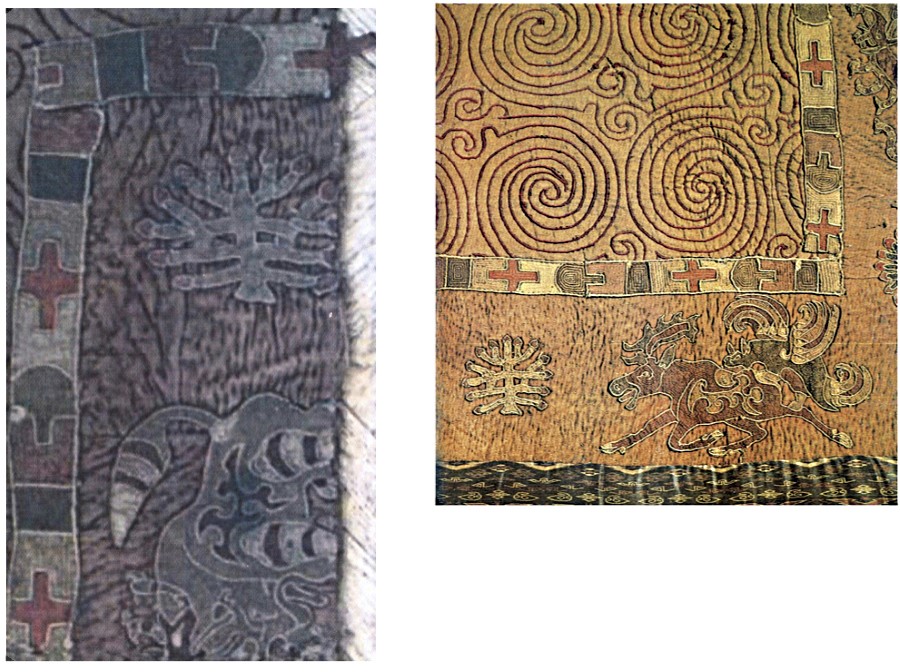
‘A propos’
wishful thinking: I do wonder whether the indistinct form woven in the
central medallion, fig 34A and 34B, could be a totemic
animal.
Notes
1. Painted scrolls of the Han-, Tan’g-, Song and Southern Song dynasties very rarely indeed show any rug in people’s daily life or at the Emperors’ Court (the illustration fig. 45 is the only one which I was able to retrieve, so far), and never in their enthroned ruler’s official pictures before the Ming Emperor Hongwu (1488-1505) (fig. 46).